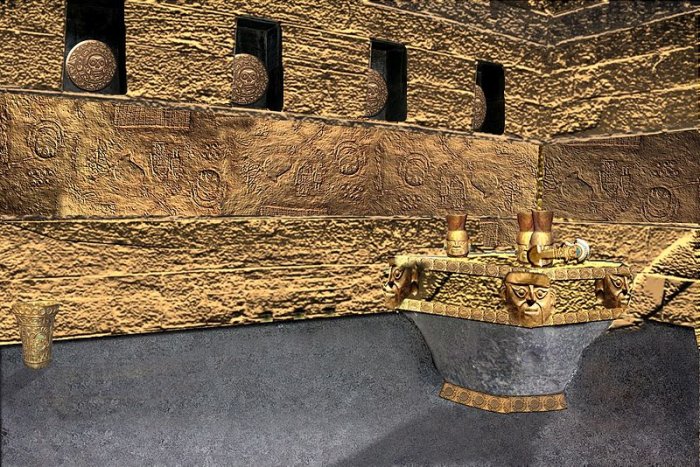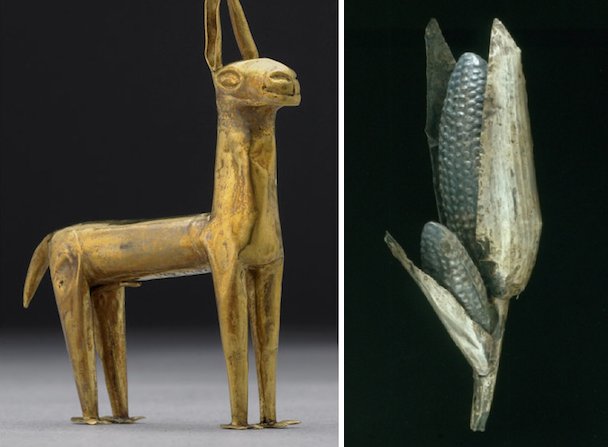Coricancha – Stunning Golden Garden And Lost Treasures Of The Inca
Ellen Lloyd - AncientPages.com - Today, there are only some ancient ruins left, but during the times of the Inca, Coricancha must have been a marvelous place to see. Coricancha was a garden of gold and silver where the Inca placed small, beautiful metal objects created in the image of plants, animals, and people.
Located in the Inca capital at Cuzco, Peru, the Coricancha (Qorikancha) complex contained the Temple of The Sun. It was dedicated to significant Inca deities such as the Creator God Viracocha, the Moon Goddess Quilla, and the Sun God Inti.
Coricancha, Cusco, Peru. Credit: Wikipedia
Myths and legends tell the Inca transported large quantities of gold to decorate the temples and their golden garden.
Qori" means goldwork, and its Spanish form is cori. "Kancha" represents an enclosed space bounded by walls. Hence, the name corresponds to approximately "place that has gold."
It is not entirely clear who constructed the Coricancha complex. The site is usually attributed to Pachacuti Inca Yupanqui, the 9th Inca ruler (1438-1471 CE). Still, Inca mythology reveals legendary Manco Capac built a temple at the site in the early 12th-century C.E, and archaeologists have unearthed pre-empire structures.
As previously mentioned in another article published on Ancient Pages, Manco Capac was the legendary founder of the Inca dynasty of Peru.
According to the Inca, Manco Capac emerged from one of the three openings in the mountain Tambotoco, near Pacaritambo (or Pacariqtambo) ('tavern of the dawn'), located some six leagues (approximately 33 km) to the south-southwest of Cuzco, Peru.
Even though his figure is mentioned in several chronicles, his existence remains unclear.
While he remains a semi-mythical figure whose actual period cannot be clearly pinpointed, he is regarded as an Inca hero. Many ancient legends connect Manco Cápac to the foundation of Cuzco.
The Lost Treasures Of Coricancha
The garden of the temple was dedicated to the great Sun God Inti. The Inca brought many offerings to their mighty deity; all garden objects were made of gold or silver.
A digital reconstruction of the room when it was filled with gold. Credit: Martinangel, Wikipedia
When the Spaniards entered Coricancha, they looted all Inca treasures and sent them to Spain.
Pedro de Cieza de León describes a golden garden in his 1554 account:
"In the month of October of the year of the Lord 1534, the Spaniards entered the city of Cuzco, head of the great empire of the Inkas, where their court was, as well as the solemn Temple of the Sun and their greatest marvels. The high priest abandoned the temple, where [the Spaniards] plundered the garden of gold and the sheep [llamas] and shepherds of this metal along with so much silver that it is unbelievable and precious stones, which, if they were collected, would be worth a city."
According to records from 1534, the Spanish king Charles V had a gold maize stalk with three leaves and two ears of corn in his collection. Royal inventories also describe gold and silver llamas, female figures, a lamb, and a male figure that is believed to have originated from Coricancha.
Left: Miniature gold llama figurine, Inka, 6.3 cm high, © Trustees of the British Museum. Right: Maize cobs, Inka, c. 1440–1533,(Ethnological Museum, Berlin)
To the Inca, who produced these small objects, the offering had much greater value than gold. The offerings had a symbolic meaning, and the miniatures of animals, plants, and figures acted as symbols of the Inca's supernatural origin in the Sun and their control over the natural world as descendants of the most powerful deity.
Today, almost nothing remains of the magnificent ancient Inca treasures except a few golden corn stalks.
The magnificent golden garden of the Inca is long gone, but fortunately, its history has not been forgotten.
If you are interested in lost Inca treasures, you may find the story of the Lost Golden Chain Of Huayna Capac intriguing.
Updated on March 24, 2024
Written by Ellen Lloyd – AncientPages.com
Copyright © AncientPages.com All rights reserved. This material may not be published, broadcast, rewritten or redistributed in whole or part without the express written permission of AncientPages.com
More From Ancient Pages
-
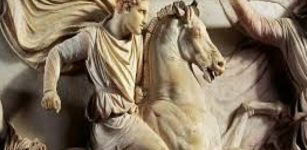 On This Day In History: Alexander The Great Died In Babylon – On June 11, 323 BC
News | Jun 11, 2016
On This Day In History: Alexander The Great Died In Babylon – On June 11, 323 BC
News | Jun 11, 2016 -
 Experiments Show The Great Sphinx May Be A Natural Formation – Scientists Say
Archaeology | Oct 31, 2023
Experiments Show The Great Sphinx May Be A Natural Formation – Scientists Say
Archaeology | Oct 31, 2023 -
 The Incas Used Stringy Objects Called ‘Quipus’ To Record Data – We Just Got A Step Closer To Understanding Them
Featured Stories | Nov 26, 2024
The Incas Used Stringy Objects Called ‘Quipus’ To Record Data – We Just Got A Step Closer To Understanding Them
Featured Stories | Nov 26, 2024 -
 Oldest Living Culture: Research Reveals Indigenous Ritual Spanning 500 Generations
Featured Stories | Jul 9, 2024
Oldest Living Culture: Research Reveals Indigenous Ritual Spanning 500 Generations
Featured Stories | Jul 9, 2024 -
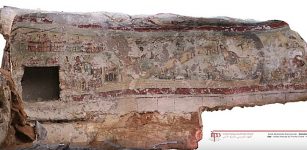 1,800-Year-Old Richly Painted Tomb Unearthed In Northern Jordan
Archaeology | Oct 1, 2018
1,800-Year-Old Richly Painted Tomb Unearthed In Northern Jordan
Archaeology | Oct 1, 2018 -
 Enigma Of Mount Ararat – Researchers Are Determined To Reveal The Truth To The World
Featured Stories | Jun 27, 2014
Enigma Of Mount Ararat – Researchers Are Determined To Reveal The Truth To The World
Featured Stories | Jun 27, 2014 -
 Mythical Shield-Maidens Did Exist – Evidence Of Female Viking Warriors Discovered
Archaeology | Sep 9, 2017
Mythical Shield-Maidens Did Exist – Evidence Of Female Viking Warriors Discovered
Archaeology | Sep 9, 2017 -
 Notre Dame Is On Fire! Can The Magnificent Cathedral Still Be Saved?
News | Apr 15, 2019
Notre Dame Is On Fire! Can The Magnificent Cathedral Still Be Saved?
News | Apr 15, 2019 -
 Freya – Vanadis: Beautiful Desirable Goddess And Her Brisingamen Necklace In Norse Mythology
Featured Stories | Jan 21, 2018
Freya – Vanadis: Beautiful Desirable Goddess And Her Brisingamen Necklace In Norse Mythology
Featured Stories | Jan 21, 2018 -
 Dreamcatcher: Powerful Protective Amulet Of North American Indian People
Ancient Traditions And Customs | Mar 20, 2020
Dreamcatcher: Powerful Protective Amulet Of North American Indian People
Ancient Traditions And Customs | Mar 20, 2020 -
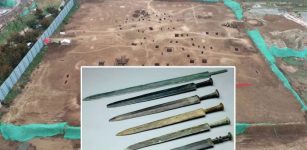 Well-Preserved Warring States Period Swords And Cultural Relics Discovered In Xiangyang, Hubei
Archaeology | Apr 5, 2024
Well-Preserved Warring States Period Swords And Cultural Relics Discovered In Xiangyang, Hubei
Archaeology | Apr 5, 2024 -
 Strange 1,000-Year-Old Artifact Melted Out Of The Ice Identified With Help Of Photo!
Archaeology | Jan 31, 2023
Strange 1,000-Year-Old Artifact Melted Out Of The Ice Identified With Help Of Photo!
Archaeology | Jan 31, 2023 -
 Why Have So Few Who Have Seen This Mysterious Victorian-Era Entity Survived?
Featured Stories | Sep 8, 2024
Why Have So Few Who Have Seen This Mysterious Victorian-Era Entity Survived?
Featured Stories | Sep 8, 2024 -
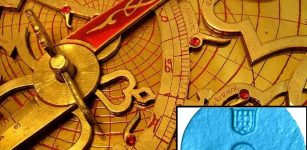 World’s Oldest Marine Navigation Tool Was A Sophisticated Astrolabe
Archaeology | Oct 25, 2017
World’s Oldest Marine Navigation Tool Was A Sophisticated Astrolabe
Archaeology | Oct 25, 2017 -
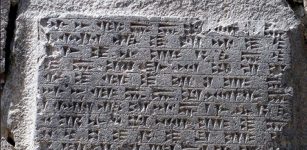 Ancient City Of Metsamor – Captured And Destroyed By Argishti I, The Ruler Of Urartu
Civilizations | Sep 11, 2015
Ancient City Of Metsamor – Captured And Destroyed By Argishti I, The Ruler Of Urartu
Civilizations | Sep 11, 2015 -
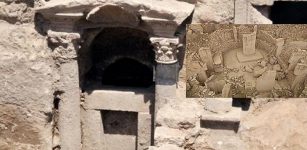 Kizilkoyun Necropolis: Excavations Of 2,000-Year-Old Rock Tombs Will Solve Mysterious Past Of Göbeklitepe
Archaeology | Sep 7, 2020
Kizilkoyun Necropolis: Excavations Of 2,000-Year-Old Rock Tombs Will Solve Mysterious Past Of Göbeklitepe
Archaeology | Sep 7, 2020 -
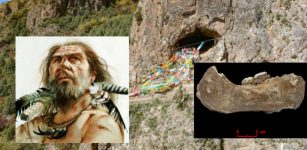 Denisovans Were First To Adapt To High Altitude And Harsh Conditions Of Tibetan Plateau
Archaeology | May 2, 2019
Denisovans Were First To Adapt To High Altitude And Harsh Conditions Of Tibetan Plateau
Archaeology | May 2, 2019 -
 Humans Carry DNA From An Ancient, Unidentified Ancestor – Scientists Say
DNA | Apr 13, 2023
Humans Carry DNA From An Ancient, Unidentified Ancestor – Scientists Say
DNA | Apr 13, 2023 -
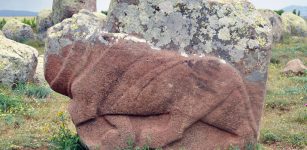 Mystery Of Gigantic Lion Sculptures Dated To The Hittite Era
Archaeology | Apr 14, 2016
Mystery Of Gigantic Lion Sculptures Dated To The Hittite Era
Archaeology | Apr 14, 2016 -
 2,000-Year-Old Completely Preserved Shipwreck With Amphorae Found Near Šćedro Island
Archaeology | May 14, 2024
2,000-Year-Old Completely Preserved Shipwreck With Amphorae Found Near Šćedro Island
Archaeology | May 14, 2024



